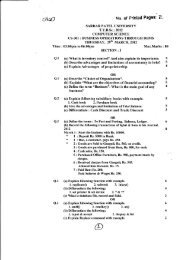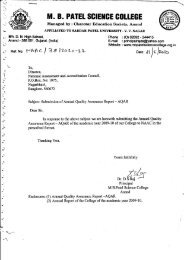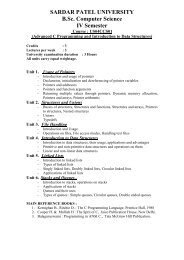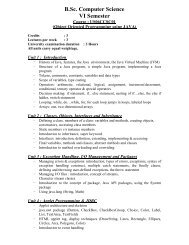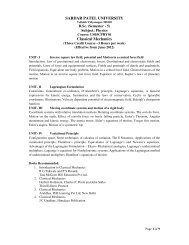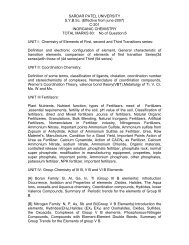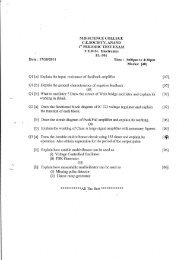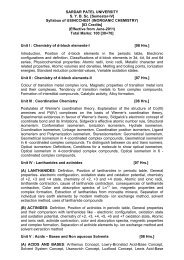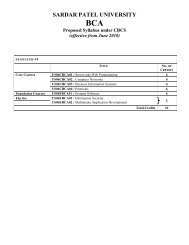SARDAR PATEL UNIVERSITY Revised syllabus Effective from June ...
SARDAR PATEL UNIVERSITY Revised syllabus Effective from June ...
SARDAR PATEL UNIVERSITY Revised syllabus Effective from June ...
Create successful ePaper yourself
Turn your PDF publications into a flip-book with our unique Google optimized e-Paper software.
<strong>SARDAR</strong> <strong>PATEL</strong> <strong>UNIVERSITY</strong><strong>Revised</strong> <strong>syllabus</strong> <strong>from</strong> <strong>June</strong> 2003T. Y. B. Sc. ELECTRONICSEL-3038-bit Microprocessor Programming and ApplicationTotal marks: 120 (External 80, Internal 40) 3 periods per weekUniversity Examination duration-3hoursUnit – 1The 8085 microprocessing unit, BUS timing, Demultiplexing the bus, Generatingcontrol signal, A detailed look at the 8085 MPU and its architecture, Example of8085 based microcomputer.Unit – 2Instruction classification, Instruction format, Method of wiring & executing asimple program, Instruction timing & operation status, Overview of the 8085instruction set, Arithmetic instruction set, Addressing modes, Data transferinstruction set, Logical instruction set.Unit -3Branch operations, Writing assembly language programs, Debugging a program,Programming techniques: looping, counting and indexing, Additional datatransfer and 16 – bit arithmetic instructions, Arithmetic operation related tomemory, logic operation: rotate and compare, Dynamic debugging.Unit – 4Counter & time delays, Hexadecimal counter, Modulo 10 counter, Pulse timingfor flashing lights, Debugging counter & time delay programs, Stack subroutines :Conditional & unconditional CALL & RETURN instructions, Advanced subroutineconcepts.Unit – 5Code conversion: BCD to BINARY, BINARY to BCD, BCD to Seven segment,Binary to ASCII, ASCII to Binary, BCD addition, BCD subtraction, Introduction toadvanced instruction and applications, Mulitiplication Subtraction with carry.Unit – 6The 8085 interrupts, Interrupts instructions and their utilization, restart assoftware instructions, interfacing data converter: DAC & ADC.Text Books:Microprocessor, architecture, programming & applications with 8085/8080Ramesh S. Gaonkar (Unit 1 to 6)
<strong>SARDAR</strong> <strong>PATEL</strong> <strong>UNIVERSITY</strong><strong>Revised</strong> <strong>syllabus</strong> <strong>from</strong> <strong>June</strong> 2003T. Y. B. Sc. ELECTRONICSEL-305INDUSTRIAL ELECTRONICSTotal marks: 120 (External 80, Internal 40) 3 periods per weekUniversity Examination duration-3hoursUNIT: 1Thyristor: Symbolic representation, Constuction details, principles of operationand transistor, analog, Methods of turning ON, Turn off mechanism, Devicespecification, Ratings and nomenclature, Gate characteristics, Circuit for gatetriggering, Internal power dissipation and temperature rise, Series and Paralleloperation of SCRs, String efficiency.UNIT:2Thyristors, Low power devices: UJT, UJT relaxation oscillator, UJT’s frequencystability, Triac, Triggering mode, Phase control using Triac, Power control, staticcircuit breaker, Over voltage protection, Zero voltage switch, Integral cycletriggering, Time delay circuit, soft start circuit, Logic and digital pulse circuit,Pulse circuit.UNIT:3AC, DC Stepper Motor, Types of inverters, Working of inverter with simplifiedcircuit, Analysis of single phase inverter, Effect of feedback diode, Current fedinverters, Series capacitive inverters, Unilateral and Bilateral inverters, Seriesinverters.UNIT: 4Phase control, Full wave control circuits, Half wavecontrol bridge circuits, Dualconverter, Phase control circuit, Modified RAM control, Control by VCO,Deratings of SCRs in phase controled, Application to speed control of motors,Regulated DC power supplies.UNIT: 5Choppers : On Off control, Rotor on-off control of DC motor, Chopper circuits,Improved chopper circuits, Step up choppers, Multiphase chopper circuits, Twoquadrant choppers, AC choppers, Thyristor protection circuits, Gate controlcircuit, Over voltage and over circuit protection, Design of snubber circuit, SCRmounting.
UNIT: 6Introduction to digital control system, Digital control system modeling, Samplingprocess, System terminology, General sample data system variable, Advantageand Disadvantage of digital control systems.Text Book:1. An introduction to thyristor and their application (Unit 1, 2, 4, 5)M. Ramamoorthy2. Thyristor power controller (Unit 3, 6)G.K.Dubey, S.R.Doralde, A.Joshi.Reference Books:1. Power Electronics by P. C. Sen2. Industrial Electronics By James T. Humptires and Lestic Sheets.
<strong>SARDAR</strong> <strong>PATEL</strong> <strong>UNIVERSITY</strong><strong>Revised</strong> <strong>syllabus</strong> <strong>from</strong> <strong>June</strong> 2003T. Y. B. Sc. ELECTRONICSEL-306Analog Communication and Fiber OpticsUNIT: 1Definition of AM, Expression of AM Voltage, Waveforms of AM Signal, Definitionof FM, Expression of FM Voltage, Waveforms of FM signal, Classification ofRadio receiver, Salient Features of broadcast receiver, Basic function of AMReceiver, Principal and block diagram of super hetrodyne receiver, RF amplifierImage signal rejection, frequency Mixer and Converter IF amplifier, Detectorstage Automatic Gain Control Automatic Frequency Control.UNIT: 2Introduction, Aspect ratio, Rectangular Switching Interlaced scanning, CompositeVideo signal, Video Modulation, Sound Modulation, Reception techniques ofVestigial sideband signal, TV camera Tubes, Image orthicon, Vidicon, VideoProcessing of camera tube output.UNIT: 3Block diagram and function of RF tuner, RF tuner circuits, Video IF amplifier,Inter stage coupling methods, Transistor video If amplifier circuits, Videodetector, Polarity of video detector output, DC component restoration, Separationand reproduction of sound, Intercarrier sound system, Video amplification, Lowfrequency compensation, TV receiver video circuits, AGC circuits, Transistorkeyed AGC.UNIT: 4Introduction, Principles of colour TV, Colour TV camera, Picture tube in CTVsystem, Picture tube in CTV, Shadow mask picture tube, Trinitron colour picturetube, In line colour picture tube, Colour TV transmission & reception, NTSCencoder and decoder, Secam system, PAL system.UNIT: 5Comparision of fibre with metal cable, Fibre construction, Principal of fiber optics,Advantage of fibre optics, Types of Fibre: Step index fiber, Single mode andmultimode fibre, Graded index fibre and other type of fiber, Acceptance angleand Numerical aperature, Fiber losses and dispersion.
UNIT: 6Sources: LED, Laser, Detector- photodiode, Avalanche photodiode, splicing offiber, Block diagram of fiber optics communication system, Repeaters, Fibercables.Text Books:(Applied Electronics Vol. II)1. Radio Engineering : G.K.Mithal (Unit – 1 to 4)2. Electronics Communications : Robert. J. Schoenbeck (Unit 1 to 6)3. Basic Radio and Television : S.P.Sharma4. Electronics Communication : Dennis Roody & John Coolen5. Electronics Communication system : George Kennedy6. Fiber optics Communication : D.C.Agarwal (Unit – 5, 6)7. Optics Fiber Communication: Gerd Keiser (Unit – 5, 6)
<strong>SARDAR</strong> <strong>PATEL</strong> <strong>UNIVERSITY</strong><strong>Revised</strong> <strong>syllabus</strong> <strong>from</strong> <strong>June</strong> 2003T. Y. B. Sc. ELECTRONICSEL-307PRACTICALSTotal marks: 120 (External 80, Internal 40)University Exam duration-2 practicals of 3hours eachNumber of periods per week: Total 18 periods for EL-307, EL-308 & EL-309LIST OF EXPERIMENTS1. Feedback Amplifier2. Wide band amplifier3. Phase shift and Wein bridge Oscillator Using Transistor4. Heartle and Colpits Oscillator Using transistor5. Push Pull Amplifier6. Regulated power supply using 78XX, 79XX7. Regulated power supply using 7238. SMPS9. OP-AMP Parameters10. OP-AMP Application- I (Inv, Noninv, Instru- amplifier,Adder,Sub,Scalar)11. OP-AMP Application- II(Wein Bridge, Phase shift, Heartly,Colpits, Square wave generator)12. OP-AMP Comparator13. Filter Using OP-AMP (Low pass, Band Pass, Band reject, All pass )14. Astable and its application using 55515. Monostable and its application using 55516. Clippling and Clamping Circuit17. Shift registers (SISO,SIPO,PIPO,PISO)18. 74LS83 Applications19. R-2R, Weighted registers, (DAC)20. Counter type A/D Converter21. Dual slope(ADC)22. ADC 0801 & DAC 08023. Wheaston Bridge24. Kelvin Bridge25. Maxwell Bridge26. Hay Bridge27. Schering BridgeAnd other experiments based on Syllabus.
<strong>SARDAR</strong> <strong>PATEL</strong> <strong>UNIVERSITY</strong><strong>Revised</strong> <strong>syllabus</strong> <strong>from</strong> <strong>June</strong> 2003T. Y. B. Sc. ELECTRONICSEL-308PRACTICALSTotal marks: 120 (External 80, Internal 40)University Exam duration-2 practical of 3hours eachNumber of periods per week: Total 18 periods for EL-307, EL-308 & EL-309LIST OF PRACTICALS1. Decimal addition of two-8bit number Sum, 16-bit using microprocessor80852. Hexadecimal Addition of two-8-bit number sum;16-bit using Microprocessor80853. Addition of two 16-bit numbers Sum; 16 bit using microprocessor 80854. 2’s Compliment of 16 bit number any microprocessor 80855. Find the largest <strong>from</strong> a series of numbers using microprocessor 80856. To arrange a series of number in desending order using microprocessor80857. Sum of series of 8-bit Hexadecimal number8. Sum of 8-bit/16-bit9. Sum of series of 8-bit decimal number sum : 16 bit10. Hexadecimal Multiplication – Product:16Bit11. Hexadecimal division-division:16bit12. LVDT13. SCR Characteristics14. Triac Characteristics15. UJT Characteristics16. Diac Characteristics17. Phase Control Circuit using Triac18. Ramp Generator Using UJT19. Amplitude Modulation & Demodulation20. Frequency Modulation & Demodulation21. Phase Modulation & Demodulation22. Application Based on Fibre Optics23. Study of Radio-receiver24. Study of TV-receiverAnd other experiment based on Syllabus.
<strong>SARDAR</strong> <strong>PATEL</strong> <strong>UNIVERSITY</strong><strong>Revised</strong> <strong>syllabus</strong> <strong>from</strong> <strong>June</strong> 2002T. Y. B. Sc. ELECTRONICSEL-309PROJECTTotal: 120 marksIn this course every students of T. Y. B. Sc.(Electronics) is expected to completeone project during the tenure of course and required to submit the project reportof 25-30 pages after completion of project for examination through demonstrationand oral discussion Some project as a guideline are suggested below butspecification within the projects may be varied or an all together new project canbe taken upon the suggestion of the teacher commensurate with the existingfacilities and the <strong>syllabus</strong> in force.1. Design and construction of Transistor Tester2. Design, construction and testing of a power supply of desired specification3. Assembly of a radio receiver4. Assembly of different section of TV set5. Construction of Function Generator6. Construction of binary counter with LED display7. Construction of Digital Clock8. Construction of Traffic Light signal Model9. Construction of Timer10. Design & Construction of Electronics Fan Regulator11. Design & Construction of different tone Doorbell12. Fault finding and repair of multimeter/CRD13. Construction of sound generator14. Construction of in circuit transistor tester15. Construction of Electronics Stop watch16. Construction of Electronics thermometer17. Microprocessor based Electronics applications18. Two way intercom19. Miniature Hearing Aid20. Water level indicator21. Light activated Alarm22. Emergency Light23. Stereo Amplifier24. Universal Logic Probe25. Burglar or Fire alarm26. Automatic Defroster27. Temperature Controller28. TV Booster29. Combined inverter, Charger and Eliminator30. Capacitance Meter31. Troubleshooting in measuring instrument, Electronics equipment32. PCB DesigningAnd other projects based on SyllabusReference Book: Electronics Projects- Volume 1 to 14 (EFY publication)
and other Electronics Magazine




